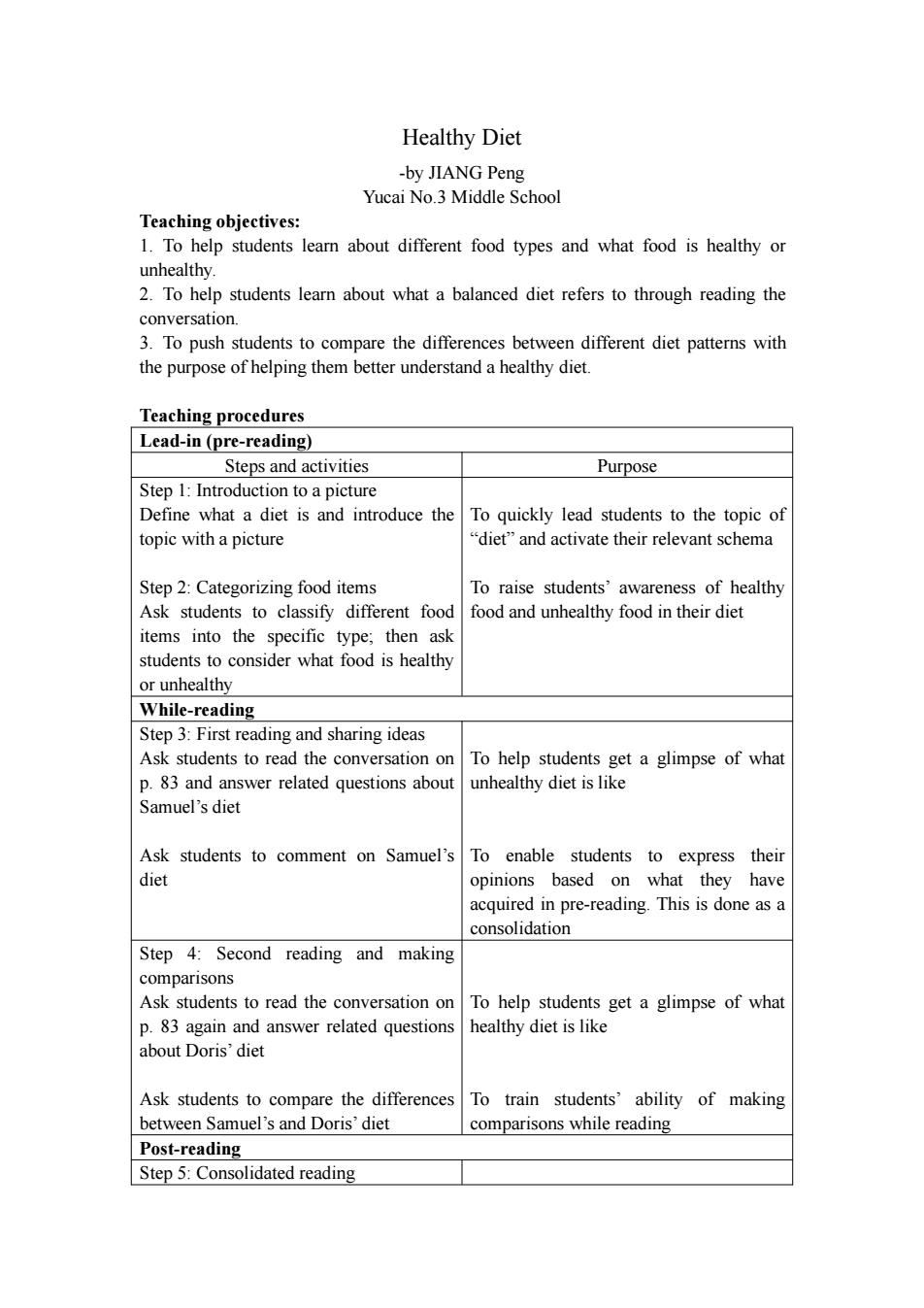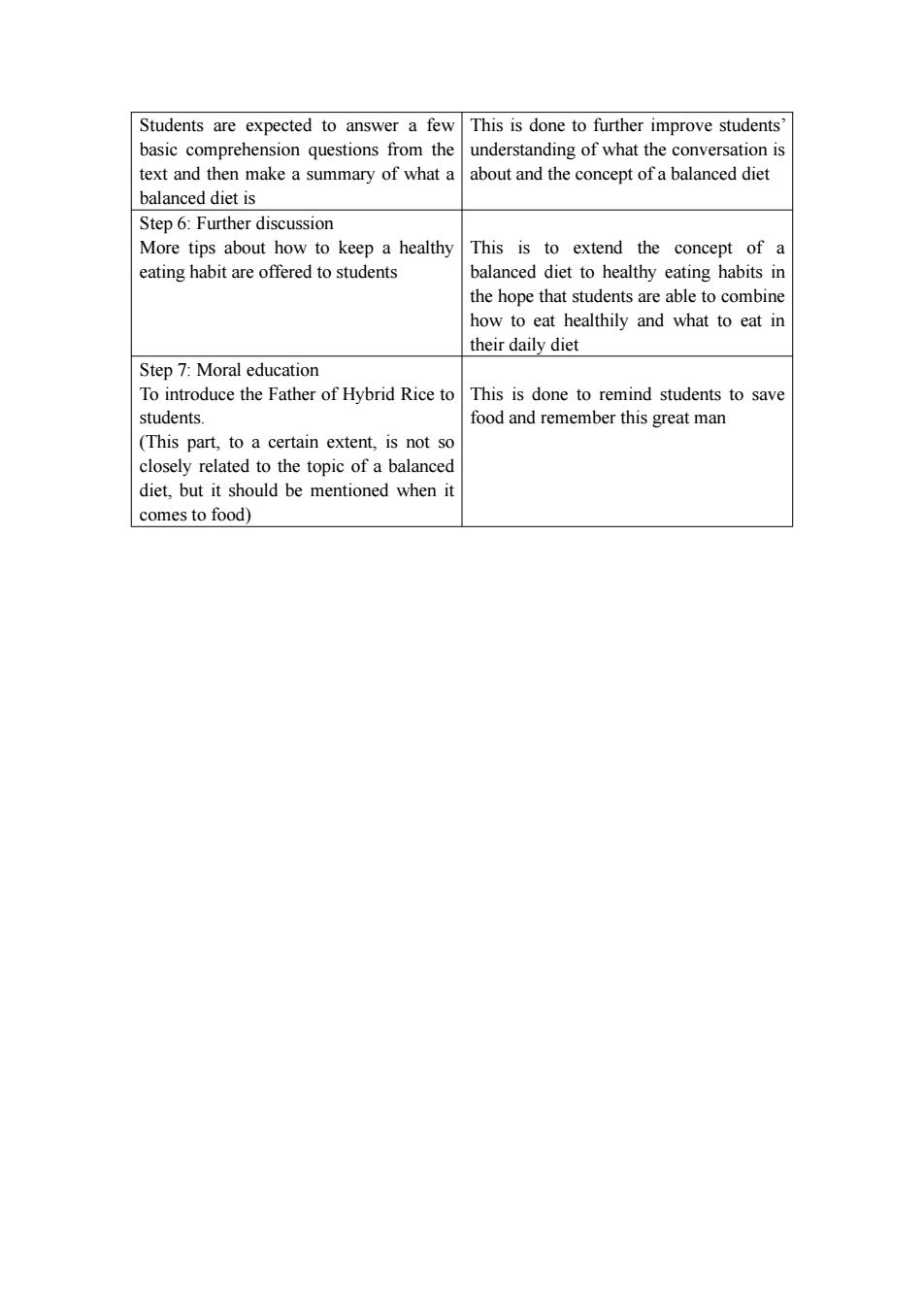
Healthy Diet -by JIANG Peng Yucai No.3 Middle School Teaching objectives: 1.To help students learn about different food types and what food is healthy or unhealthy. 2.To help students learn about what a balanced diet refers to through reading the conversation. 3.To push students to compare the differences between different diet patterns with the purpose of helping them better understand a healthy diet. Teaching procedures Lead-in(pre-reading) Steps and activities Purpose Step 1:Introduction to a picture Define what a diet is and introduce the To quickly lead students to the topic of topic with a picture "diet"and activate their relevant schema Step 2:Categorizing food items To raise students'awareness of healthy Ask students to classify different food food and unhealthy food in their diet items into the specific type;then ask students to consider what food is healthy or unhealthy While-reading Step 3:First reading and sharing ideas Ask students to read the conversation on To help students get a glimpse of what p.83 and answer related questions about unhealthy diet is like Samuel's diet Ask students to comment on Samuel's To enable students to express their diet opinions based on what they have acquired in pre-reading.This is done as a consolidation Step 4:Second reading and making comparisons Ask students to read the conversation on To help students get a glimpse of what p.83 again and answer related questions healthy diet is like about Doris'diet Ask students to compare the differences To train students'ability of making between Samuel's and Doris'diet comparisons while reading Post-reading Step 5:Consolidated reading
Healthy Diet -by JIANG Peng Yucai No.3 Middle School Teaching objectives: 1. To help students learn about different food types and what food is healthy or unhealthy. 2. To help students learn about what a balanced diet refers to through reading the conversation. 3. To push students to compare the differences between different diet patterns with the purpose of helping them better understand a healthy diet. Teaching procedures Lead-in (pre-reading) Steps and activities Purpose Step 1: Introduction to a picture Define what a diet is and introduce the topic with a picture Step 2: Categorizing food items Ask students to classify different food items into the specific type; then ask students to consider what food is healthy or unhealthy To quickly lead students to the topic of “diet” and activate their relevant schema To raise students’ awareness of healthy food and unhealthy food in their diet While-reading Step 3: First reading and sharing ideas Ask students to read the conversation on p. 83 and answer related questions about Samuel’s diet Ask students to comment on Samuel’s diet To help students get a glimpse of what unhealthy diet is like To enable students to express their opinions based on what they have acquired in pre-reading. This is done as a consolidation Step 4: Second reading and making comparisons Ask students to read the conversation on p. 83 again and answer related questions about Doris’ diet Ask students to compare the differences between Samuel’s and Doris’ diet To help students get a glimpse of what healthy diet is like To train students’ ability of making comparisons while reading Post-reading Step 5: Consolidated reading

Students are expected to answer a few This is done to further improve students' basic comprehension questions from the understanding of what the conversation is text and then make a summary of what a about and the concept of a balanced diet balanced diet is Step 6:Further discussion More tips about how to keep a healthy This is to extend the concept of a eating habit are offered to students balanced diet to healthy eating habits in the hope that students are able to combine how to eat healthily and what to eat in their daily diet Step 7:Moral education To introduce the Father of Hybrid Rice to This is done to remind students to save students. food and remember this great man (This part,to a certain extent,is not so closely related to the topic of a balanced diet,but it should be mentioned when it comes to food)
Students are expected to answer a few basic comprehension questions from the text and then make a summary of what a balanced diet is This is done to further improve students’ understanding of what the conversation is about and the concept of a balanced diet Step 6: Further discussion More tips about how to keep a healthy eating habit are offered to students This is to extend the concept of a balanced diet to healthy eating habits in the hope that students are able to combine how to eat healthily and what to eat in their daily diet Step 7: Moral education To introduce the Father of Hybrid Rice to students. (This part, to a certain extent, is not so closely related to the topic of a balanced diet, but it should be mentioned when it comes to food) This is done to remind students to save food and remember this great man